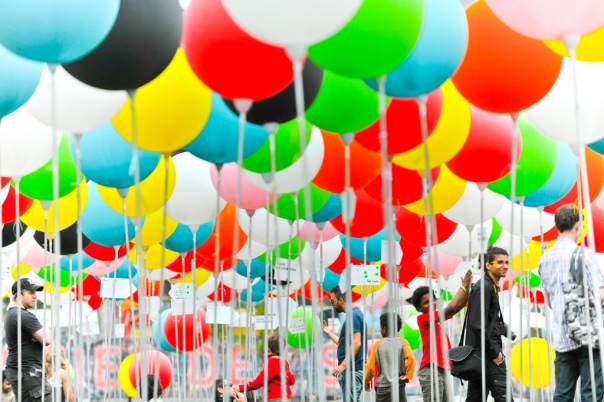On a recent trip to a frozen Kansas City, to see our friend Derek—who very recently became a surprise contributor to this blog—we visited the Nelson-Atkins Museum of Art. As we walked in, Derek asked if we’d featured the Bloch Building, Steven Holl’s half-submerged addition, in our magazine. I told him we hadn’t.
What I didn’t know was that we were about to.
In our upcoming issue, we begin a 3-part feature story on sustainable design in museums, and the Bloch Building concludes Part 1. It’s a good story overall, the main premise being that in a down economy, out-of-work architects are keeping themselves busy with some fantastic work for institutions like museums and universities. This work also tends to incorporate environmentally conscious design.
But literally hours after editing the museum story, I’m on the train, opening up Blair Kamin’s Terror and Wonder: Architecture in a Tumultuous Age, and I read something disconcerting:
“A little-noticed pattern repeated after architecture critics cheered each building’s opening and then departed for the next extravaganza: attendance and revenues didn’t match projections, and once the recession dramatically reduced the value of endowments, the sponsors of the new edifices were forced to lay off staff and cut hours as well as operating expenses. At Steven Holl’s partly underground addition to the Nelson-Atkins Museum of Art in Kansas City, cost-cutting literally meant dimming the beauty of the addition’s proudest feature—the glass pavilions, or lenses, that drew daylight into the galleries and shone like jewels at night—for 14 hours per week. If you built it, they didn’t necessarily come.”
Others had a different story, but admitted that Holl’s Bloch Building wasn’t the boon to the Nelson-Atkins that the Modern Wing was to the Art Institute. Perhaps Montreal’s Museum of Possibilities had, if not the, at least one answer.
“The ‘Museum of Possibilities’ was created for one day during Montréal’s city-wide open day for Museums. Members of the public could pick up a piece of paper and write down what they would like to have happen in that space in the future. Visitors entered the field of balloons to add an ‘entry’ to the museum of possible things which might happen on site. People also received a set of stickers so they could wander through the Museum of Possibilities and add a vote of approval for possible future events. This voting helped to turn ‘possibilities’ into probabilities and gave the client concrete data on public interest.”
Even as this project’s inventive creators designed a way to build precisely what the public wants, another new project may only further stymie museum attendance: Google’s Art Project, released last Tuesday.
Explore museums from around the world, discover and view hundreds of artworks at incredible zoom levels, and even create and share your own collection of masterpieces.
I will not scoff at such a thing; this truly historic endeavor will no doubt be an unrivaled resource for art students and an exploratory map for enthusiasts. But I will ask: Does every item in our real-world inventory need a digital back-up? With a few clicks I can stand before van Gogh’s “Portrait of Joseph Roulin” (and can link to it). But I am not standing there. I am slumped in my office chair, drinking office-supplied Dunkin Donuts coffee. And the computer-game movement, the washed-out colors, the blurred edges all compose a feeling that is nearly the complete opposite of actually strolling through the MoMA.
Would the utter violence of Ray Metzker‘s photographs have come through had I been struggling to face them during a “Google-powered” excursion instead of in the dark corridor of the Bloch Building’s special exhibit hall?
The same questions were brought up by a similar Google endeavor a few years ago: Google Earth. Is it better to have at least seen a photo of Iceland than to have never seen it at all? And so I ask now: Is it better to simulate a trip to the Uffizi Gallery in Florence than to never know it exists?
::
[Photos: Steven Holl Architects (top), kelseysnook]


